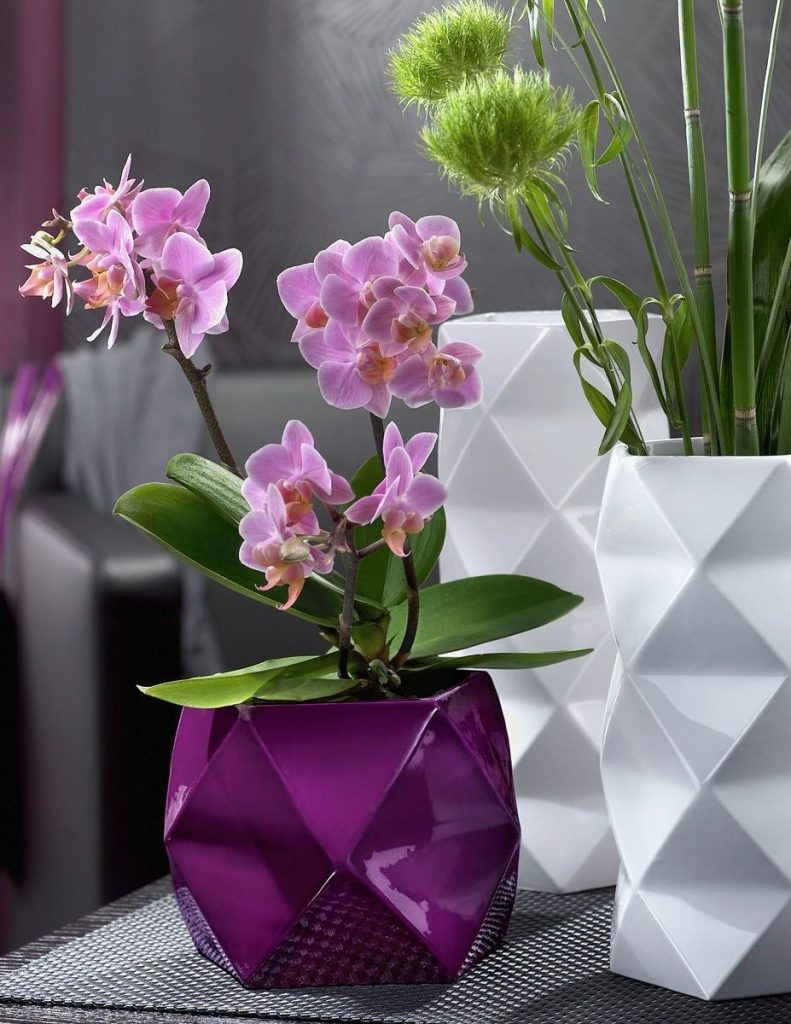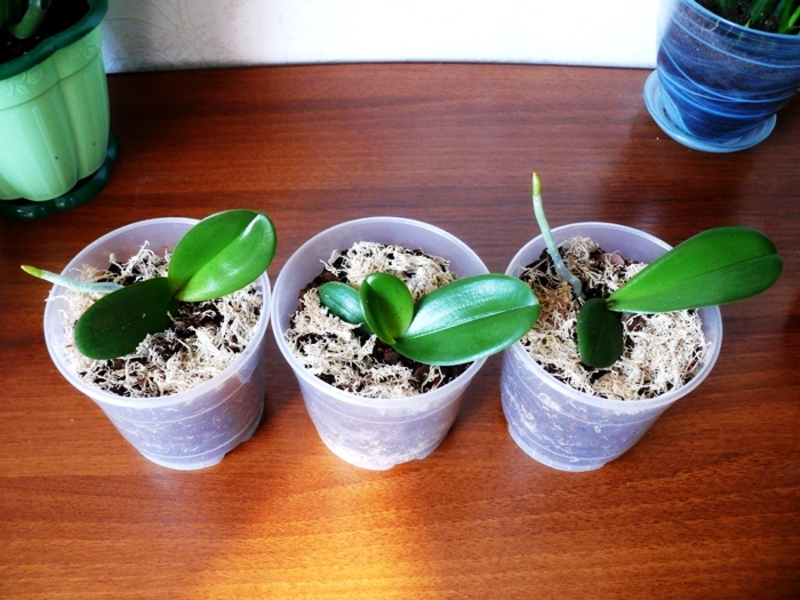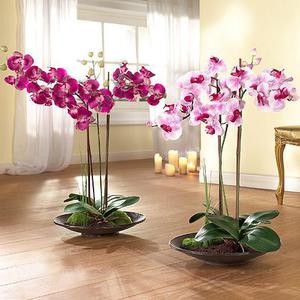 Watching television programs about tropical flora, we are always amazed at the riot of colors and forms of plants growing in those latitudes. Did you know that there are many plants from tropical latitudes that can be quite successfully kept at home, and they will delight you no less than those on the TV screen? In order to prove this, let's take, for example, an orchid, a flower - which is striking in its originality and at the same time simplicity for growing.
Watching television programs about tropical flora, we are always amazed at the riot of colors and forms of plants growing in those latitudes. Did you know that there are many plants from tropical latitudes that can be quite successfully kept at home, and they will delight you no less than those on the TV screen? In order to prove this, let's take, for example, an orchid, a flower - which is striking in its originality and at the same time simplicity for growing.
How to grow an orchid at home
Although they are considered capricious plants, many flower lovers, both professionals and amateurs, they grow on windowsills without any difficulty. To successfully grow orchids at home, you need to prepare well from the beginning, and then everything will go “knurled” and will be simple and easy. It is necessary to prepare several things: soil, containers for a flower, fertilizer. Most flower shops have all of this in abundance. You also need to study information about watering, lighting, transplanting. It is not necessary to delve into the details, but it is necessary to study the general information.
What should be the lighting
What always attracts us in any color is, of course, the bloom itself. So how to grow an orchid at home, and even so that it blooms? This requires a lot of light. Moreover, lighting has a major role here. The most important thing is to find a middle ground, because if there is too much light, the flower will just burn, and with a lack of light, the plant will not bloom at all. The question immediately arises, how to determine this golden mean. Here the flower will tell you. With a lack of light, the leaves will be dark green (should be light), and if you overdo it with lighting, the leaves will begin to turn yellow.
Features of watering a plant
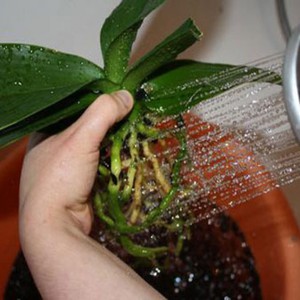 Watering is also important along with lighting. In nature, orchids never grow in water, their roots cannot tolerate excess moisture and standing water, so extreme caution must be exercised with watering. Factors affect the frequency of watering:
Watering is also important along with lighting. In nature, orchids never grow in water, their roots cannot tolerate excess moisture and standing water, so extreme caution must be exercised with watering. Factors affect the frequency of watering:
- the length of daylight hours;
- the size of the container in which the plant is located;
- watering and feeding;
- other external factors such as dry air and ambient temperature.
The plant will immediately react to a lack of moisture with dark green leaves, and to waterlogging yellow leaves and rotten roots.
Increased watering is required only during rapid growth or flowering. Watering should be done as follows. It is necessary to water the plant in a shower with warm water so that the soil is completely wet and the water completely drains out through the drainage holes. Only after the water has completely drained can the plant be put back into the pots.
Selection of soil and capacity
The choice of a pot is very important for the favorable growth of the flower. Mainly used:
- transparent plastic containers;
- clay pots;
- baskets.
Some types of orchids from the epiphyte family are planted on a block. The block can be a piece of bark, and in order to prevent the roots from drying out, moss is used to retain moisture. Mostly miniature species or seedlings are planted on the block.
Now let's look at the soil. The selection of the substrate depends on what kind of variety you want to grow.If it is an orchid from the epiphyte family, then the soil will mainly play the role of supporting the plant in an upright position, protect the roots from excess moisture and provide them with the required amount of air. The substrate should consist of pieces of tree bark, coal, cork, moss, clay in granules and absolutely no garden soil, in general, from those components that do not retain moisture. Also possible addition of coarse sand.
Any container capable of holding the substrate of the required composition is suitable as a flower pot. To grow terrestrial species, we need a substrate of the same composition as for epiphytes, but with the addition of a small amount of garden soil and dried leaves. All components must be finely ground. It is best to use plastic transparent containers with drainage as a pot. To hide the untidiness of the containers, you can always place the flower in a decorative planter. It is both beautiful and practical.
For beginners, it is advisable to buy ready-made soil in stores, rather than prepare it yourself. On the packaging, sometimes they even write for what type of this or that substrate. After gaining some experience, you can try to prepare soil for ground orchids yourself from a soil mixture for epiphytes, moss and garden soil.
Optimum temperature for the plant
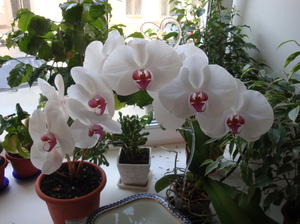 Most plants require daytime temperatures from +18 to +27 degrees, and at night from +13 to +24 degrees. One of the most important conditions for flowering is the difference between night and day temperatures. With central heating, transferring a plant accustomed to heat to a cooler area overnight can produce good results. The plant can sprout. Orchids prefer air humidity of 60–80%.
Most plants require daytime temperatures from +18 to +27 degrees, and at night from +13 to +24 degrees. One of the most important conditions for flowering is the difference between night and day temperatures. With central heating, transferring a plant accustomed to heat to a cooler area overnight can produce good results. The plant can sprout. Orchids prefer air humidity of 60–80%.
If these figures are lower, then they can be achieved by placing a pallet with a grate under the pot. Such pallets can be purchased either in garden stores, or you can make it yourself by pouring water onto the bottom and placing a large layer of gravel on top. The main thing is to make sure that the roots do not touch the water.
In dry weather, spraying from a spray bottle will be helpful. Only it is worth calculating the time so that the plant has time to dry out by night. Plants are very air movement is also important... Especially for cold-loving species. An electric fan can be used for this. But it is worth protecting the plant from strong drafts. While blowing the plant, it is worth increasing the frequency of watering the flower.
Fertilizer selection
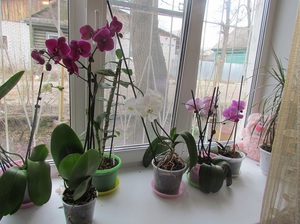 For abundant flowering, regular, balanced feeding is necessary. It is best to do it once every two weeks. It is best to use specialized fertilizers for orchids, which can always be purchased at flower shops. The rules for preparing top dressing are usually written on the package.
For abundant flowering, regular, balanced feeding is necessary. It is best to do it once every two weeks. It is best to use specialized fertilizers for orchids, which can always be purchased at flower shops. The rules for preparing top dressing are usually written on the package.
In no case should you use fertilizers that are intended for other plants. This can lead to illness or even death of the flower. It is also worth remembering that during the rest period one should reduce the frequency of feeding... Sooner or later, the plant will need to be transplanted into a new pot. This is best done after the plant has bloomed and rested a little. The signal for this is the green part of the plant that has grown outside the pot. It is important to remember that you do not need to transplant if the root system just protruded above the surface of the container.
Plant transplant recommendations:
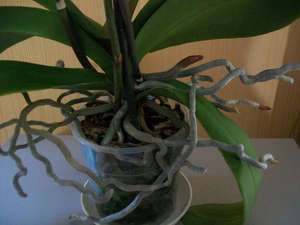 Sometimes, in order to gently remove the plant from the pot without damaging the root system, you have to cut the pot.
Sometimes, in order to gently remove the plant from the pot without damaging the root system, you have to cut the pot.- After that, it is necessary to carefully shake off the plant from the old soil, cut off the old dried or rotten roots.
- Then you need to take a container a couple of sizes larger than the old one, pour some new soil on the bottom, put the orchid in a new pot and fill the space between the roots with a suitable substrate.
- Then press down lightly on the soil, but do not over-compact.It is also necessary to ensure that the top of the flower (growth point) is above the ground surface.
On reproduction of orchids at home not everyone is solved, since this is associated with a number of difficulties. There are two ways to propagate a flower - this division during transplantation and seeds... Reproduction by seeds is considered impossible, since in a plant they are the size of pollen and require absolutely sterile conditions for germination, since even the slightest microbes can destroy them. Therefore, if you do not have a mini-laboratory at home, then you should not try. Reproduction by division is also difficult, but still quite real. And if a new plant develops a system of roots and leaves, then in a year it will delight you with flowers and become a wonderful decoration for your home.

